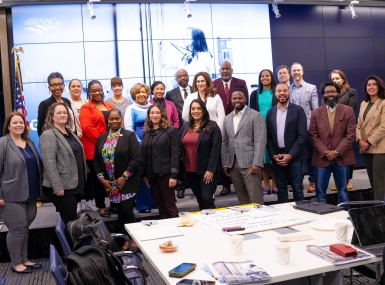Bright Ideas - April 18, 2016
Upcoming Events
Related News
New County Animal Control Program Leaps Beyond the Traditional Dog Pound
Problem:
Budget cuts forced the city of Peoria to cut its animal control program.
Solution:
The county created its own animal control program and within five years had achieved lofty goals
Problem:
Budget cuts forced the city of Peoria to cut its animal control program.
Solution:
The county created its own animal control program and within five years had achieved lofty goals
People mean it as an insult to say someone couldn’t be elected dog catcher, but it turns out it’s a pretty demanding job.
Peoria County, Ill. found that out in 2010 when county officials got some news — the city of Peoria was shutting down the animal control program, which the county contracted with for service. The county had 180 days to fill that gap.
“It was a total surprise,” said County Administrator Scott Sorrell. “They gave us notice that they cut it from their budget, and because it’s a statutorily-mandated county function, we had to be ready to pick up that service.”
The city had been serving as animal control contractor for three decades. When it fell back to the county, officials decided to not just pick up where the city left off, but to do more.
“We didn’t want to just do animal control, we wanted to brand it animal protective service, manage the shelter component and unify everything.
“We wanted to have a good balance of the public safety and animal welfare sides, but we felt like if we addressed welfare, it would have a positive impact on safety issues.”
And that also meant setting goals to increase adoption rates and decrease euthanasia rates at the animal shelter, which is jointly owned by the county, city and local humane society, and increase rabies vaccination rates in the community.
“We generally don’t want to impound as many animals,” Sorrell said. “The public and the staff decided to set our goals pretty high.”
Being able to hire all of the city department’s staff — and retain the respected director — helped. As did the county’s comparatively favorable rebound from the recession, giving it a stronger budget for the new department.
“Having a department head who was nationally recognized was a positive,” Sorrell said. “We were able to let her do things the city budget constraints kept her from doing.”
The department was able to clear more than $11,000 in profit in its first year of operation by establishing new rabies registration fees and coupling vaccinations and tags with fee collection, a step Sorrell said is not standard but made clear sense.
“It sounds simple, but few counties do it,” he said. “Usually you’ll go to the vet, get shots and then have to come to a county facility to get tags. We consolidate it all.”
In the following years, the county amended the animal control ordinance three times, strengthening anti-cruelty laws, defining “nuisance situations” and increasing penalties for vicious and dangerous dogs.
The county encouraged adoption of older dogs and cats by waiving fees and offering periodic “specials” on adoptions.
Though 75 percent of the county’s 186,000 population lives in the city of Peoria, and pet ownership follows closely, the county adapted for its rural population, creating a barn cat caretaker license that exempted sterilized barn cats from rabies registration.
In the end, by 2015, the county had exceeded most of its goals. It set out to increase its live-release rate — the rate of animals leaving the shelter alive — and instead nearly doubled it, to 46 percent from 28 percent. The euthanasia rate dropped by 50 percent for dogs and 53 percent for cats, much more than the 10 percent target. One of the main reasons rabies registrations did not increase by the 20 percent is that the rates are already quite high for a county of Peoria’s size — 79 percent license compliance rate for dogs and 30 percent for cats.
The county also set new service agreements with the 13 municipalities, agreements that are being reevaluated as they reach the end of their lives.
“We’re negotiating new deals this summer but I don’t anticipate any drastic changes in service delivery,” Sorrell said. “Throughout this process, we’ve just looked at what is mandated and what we want to do and made it work.”
Bright Ideas features noteworthy and award-winning programs.
Attachments
Related News

DOJ issues final rule for state and local governments to implement web-based accessibility standards
On April 8, the U.S. Department of Justice (DOJ) announced the release of a web accessibility final rule for state and local governments.

County Countdown – April, 22, 2024
Every other week, NACo’s County Countdown reviews top federal policy advocacy items with an eye towards counties and the intergovernmental partnership.

Equity task force shares preliminary ideas for report
NACo's Equity + Governance Task Force is working to identify, prioritize and develop tools and resources counties need to advance equity in our communities.